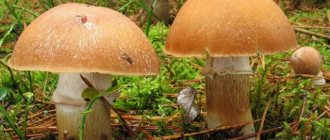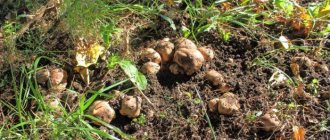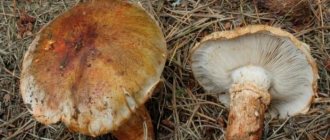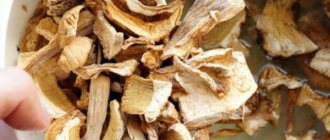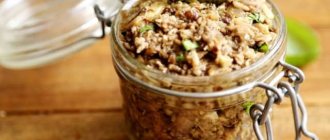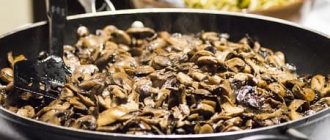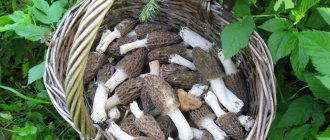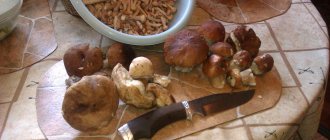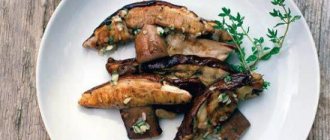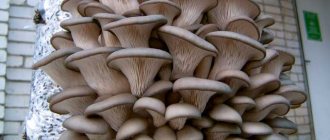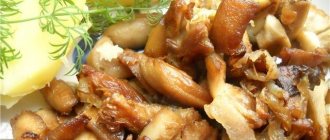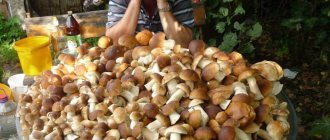Experienced housewives often stock up for the winter by storing fruits and vegetables in jars. The most favorite winter preparation is mushrooms. They are versatile in cooking, great in salads, soups, meat dishes and, of course, as a snack. One of the varieties suitable for pickling is chicken mushrooms. Inexplicable, but true: for some reason, this particular species is unreasonably not valued by mushroom pickers in pickled form. They are also edible, like many others, and taste like champignons. In European countries, this mushroom is generally considered a delicacy.
One of the varieties suitable for pickling are chicken mushrooms
Marinated chicken for the winter
Note! It is believed that the most delicious part of a chicken is the cap - tender and aromatic flesh. In addition, there is a risk of finding insects in the legs. Chickens, like any other mushrooms, are not recommended to be mixed with other varieties when pickling. But when preparing soup or salad, you can use different mushrooms. Why can’t you marinate several types together? This is because some varieties of mushrooms have their own cooking nuances. And if you cook them together, the seaming can go bad very quickly. Let's look at several options for preparing white botanicals.
After reading the recipes on our site, you can also prepare other tasty preparations, such as pickled sorrel and salted purslane for the winter.
Beneficial features
Chicken coop, like many other mushroom species, has beneficial properties. Fruiting bodies are rich in protein, vitamins, polysaccharides, but have low calorie content.
The reddening umbrella has the following effects on the body:
- strengthens the walls of blood vessels, improves heart function;
- stimulates muscle growth;
- increases the body's resistance to bacteria, viruses, i.e. stimulates the immune system;
- stimulates brain activity;
- lowers blood sugar levels;
- helps remove toxins from the liver.
Also, components of this type have an anti-inflammatory effect. Consumption of the product slows down the aging process of cells due to antioxidant activity.
Characteristic features of the variety
Despite their geographical widespread distribution, ringed caps are undeservedly ignored. This happens due to the caution of mushroom pickers who confuse edible rosetes with its poisonous counterparts.
Chicken mushrooms really resemble the pale toadstool with its skirt, which is shown in the photo, but after studying the description and differences, you can easily recognize the edible forest delicacy.
Appearance and structure
Appearance changes as it grows. At the beginning of its development, the cap has the shape of a hemisphere with slightly curled edges, which are attached to the stem. The diameter of the cap is up to 4 cm. As it grows, the edges diverge and tear the cover, leaving a ring with a skirt on the leg to prevent tearing. The cap grows up to 10 cm in diameter and takes the shape of a wide cap with a bulge in the center.
The color of the cap is brownish-pink. In dry weather, the edges of the cap dry out and crack slightly. On the inside there are white-yellow plates of the spore apparatus, which acquire a rusty tint during the maturation of the spore powder. The outer side of the cap is dissected with thin creases, covered with a light coating. At the edge, the pollen forms scales that look like those of a fly agaric, which confuses inexperienced mushroom pickers.
You may be interested in:
How to distinguish whether a Polish mushroom is edible or not: useful tips (22 photos) An interesting and most striking representative of the genus of fly mushrooms is the Polish mushroom. It belongs to the second category...Read more...
The pale yellow leg is cylindrical in shape. The structure up to the ring is more silky and bright, above the ring it is scaly and pale. The pulp is dense with a pleasant mushroom smell. The color does not change when cut.
Place of distribution
The species is distributed in Europe, Asia, Japan, and the USA. In Belarus, chickens can be found everywhere. They grow throughout the area and are popular.
Mushroom growth areas
The favorite soil is damp and acidic, on which mixed and coniferous forests, as well as lingonberry and blueberry bushes, are well distributed. You can meet chickens both in the mountains and on the outskirts of swamps, which is why they received another name - marshlanders.
Taste and collection rules
An edible, tasty mushroom, the flesh of which resembles boiled chicken breast, and is consumed fried, stewed, pickled and salted. You should go hunting from July to October-November. If you come across a mycelium of chickens, then, without leaving your spot, you can collect a bucket, because they grow in vast plantations in a circle.
Collection of chickens
Since the marsh grass can be confused with its poisonous twins, when going for this species for the first time, you should take with you someone who understands them, or a picture of the edible and dangerous species. It is also necessary to use the main rule of mushroom pickers: if you’re not sure, don’t take it.
You should not take old, wormy or rotten mushrooms. If these have already ended up in your basket, then you shouldn’t throw them away or trample them, just prick the fruiting body onto a branch, and then, when ripe, it will shed spores and increase the yield.
How to distinguish from false, inedible
The ringed cap has two terrible doubles with which an inexperienced mushroom picker can confuse it - the fly agaric and the toadstool. You can distinguish it from a fly agaric by the following characteristics:
- the scales on the fly agaric cap extend over the entire area, but on the cap only along the edge;
- The smell of the pulp of an inedible mushroom is unpleasant, while that of an edible one is mushroom-like;
- the plates of the fly agaric are free, those of the cap are adherent to the stem;
- the fly agaric has a vulva at the base, the chicken does not.
When comparing with a pale grebe, pay attention to the following signs:
- Edible mushrooms do not have a sac-like formation at the base of the stem;
- The toadstool has fused plates, but the cap does not.
Pale toadstool often grows among caps, therefore, having discovered a rich clearing, it is necessary to inspect each fruiting body that is placed in the basket.
Description and photo of chickens
Chickens resemble spider webs, and therefore were previously considered representatives of this genus. However, they have a specific appearance, thanks to which an experienced mushroom picker will not confuse them with anything else.
What do mushrooms look like?
The first thing that catches your eye is the large (up to 12-15 cm in diameter for mature mushrooms) cap-shaped cap. It is to her that the mushroom owes its name. The color of the cap varies from silvery-white to yellowish-brown (depending on the age of the mushroom).
Age also determines the shape of the cap. It changes from hemispherical to flat. The hat at first looks very much like an eggshell placed on a leg. In mature individuals, the cap looks more like a cap.
Cut flesh:
- dense;
- fibrous;
- watery;
- with a pleasant mushroom smell.
The leg is strong, pale yellow, cylindrical in shape. It reaches 12 cm in length and 3 cm in thickness. You can see a ring under the cap on the stem.
Structure and features of the species
Over time, the spherical “caps” of young mushrooms straighten and become flat with a raised center. The structure of the cap provides for the presence of thin ocher-rusty plates underneath it. Spore powder of the same shade. The plates are relatively sparse and adherent, with unequal length.
In mature chickens, the surface becomes flabby and as if sprinkled with flour. During drought, the edges of the cap crack. The leg of the ringed cap is solid, without voids. The surface of the stem is silky at the base, and closer to the cap it has thin scales. Chickens are susceptible to worms.
Marinated chicken mushrooms for the winter
It is considered a quick way to pickle mushrooms.
Ingredients for cooking:
- chickens - 1 kg;
- water - 0.7 l;
- vinegar 9% - 2/3 of a regular glass;
- table salt - 1 tbsp. l.;
- sugar - 1 tsp;
- laurel - 1-2 leaves;
- citric acid - 5 g.
How to pickle chicken mushrooms for the winter:
- Pour water into a saucepan. It is recommended to use a container with an enamel coating; aluminum cannot be used.
- Add salt, sugar and vinegar.
- As soon as the marinade boils, reduce the heat. Add pre-prepared chicken, bay leaves and cook for 15 minutes. During cooking, foam will appear on the surface. It must be collected with a slotted spoon and thrown away, otherwise the marinade will be cloudy.
- After 15 minutes of cooking the mushrooms, add acid and turn off the heat.
- Leave the mushrooms in the marinade to cool.
- Sterilize the jars.
- Place the mushrooms in jars and pour in the marinade. Roll up tightly.
Pickled greenfinches
It is necessary to marinate mushrooms so that neither salt nor vinegar interrupts their taste, but rather emphasizes it.
Ingredients of the marinade:
- 1 liter of water;
- 1 dessert spoon of salt;
- 1 dessert spoon of granulated sugar;
- 2 dessert spoons of table vinegar 4.5%;
- Half a glass of vegetable oil;
- Sweet peas – 2 pcs;
- Zira – 8-12 grains;
- Rosemary – 8-12 grains.
Attention! Zira and rosemary give a delicate aroma. If necessary, they can be replaced with caraway seeds or dill. The dish will acquire a different flavor, it will be brighter, but no less original.
Cooking method:
- Washed mushrooms are boiled in two waters. The liquid is drained after boiling mushrooms in it for 5 minutes.
- The marinade is prepared in a smaller saucepan, but the last stage of cooking the mushrooms requires that the boiled mushrooms be placed in it along with the marinade.
- After the water boils, spices are added to make the brine moderately spicy. Vinegar is added last.
- The chickens are placed in a colander, washed with additional running water and placed in a pan with marinade.
- After the marinade with mushrooms boils, the gas is turned off.
- The hot product is placed in jars and covered with lids.
- Once cooled at room temperature, the jars are stored in a refrigerator or a concrete pit in the garage.
Attention! If mold has formed inside a jar of mushrooms during storage, it is better to throw it away to avoid poisoning.
Where and when does the sulfur-yellow tinder grow?
The chicken mushroom, the photo and description of which is given above, lives in regions with a mild climate. A suitable substrate for its active growth is wood. The sulfur-yellow tinder fungus is found in large quantities in North America and Europe. In Russia they are found in Siberia and the Far East. It is permissible to collect witch's sulfur from the beginning of May to the end of September.
Important! In ancient times, it was believed that tinder fungus was a kind of conductor to the spiritual world.
Doubles and their differences
The sulfur-yellow tinder fungus has two types of counterparts - gigantic meripilus and northern climacodon. Northern Climacodon is distinguished by the presence of spines on its cap. Its color can be gray-yellow or white. The mushroom is classified as inedible.
Northern Climacodon has a repulsive odor
The color of giant meripilus varies from yellow-brown to brown. This mushroom is classified as conditionally edible.
There may be scales on the surface of the doppelganger's cap.
What mushrooms can be confused with and how to distinguish them
The ringed cap can be confused with inedible and poisonous mushrooms, for example, fly agaric or toadstool. It is important to learn to distinguish cockerels from these dangerous representatives of the mushroom kingdom.
Gray fly agaric
To find the differences, you should turn the mushroom over and look at the color of the plates - in cockerels they are always yellow or brown. The fly agaric is boiling white. There are no flaps or large scales on the surface of the cockerel's cap.
The structure of the legs also varies. Chickens have a ring below the cap, above which there are small yellowish scales. Older individuals always have a skirt. In young people it is connected to the edge of the lower plate of the cap.
Death cap
The whitish tint of the cap of young caps confuses mushroom pickers. But the color of the toadstool's cap is off-white, while that of the cockerels is silver. The plates of the toadstool are easily separated from the leg, and at the base the leg is swollen with a volva and a white ring. In chickens, the ring is slightly lower than the cap and looks solid.
Preparatory stage
Chicken breast is not cooked before drying. Therefore, the choice of meat must be approached with maximum responsibility.
When buying a fillet or a whole chicken at the market or in a supermarket, the first thing you need to do is make sure the product is fresh. Poultry meat should be light, pale pink, without bruises or foreign inclusions. The smell is pleasant, slightly sweet. It is advisable to buy steamed (chilled) chicken. Frozen meat loses its juices and, although quite a bit, is worse in taste than fresh meat.
Before salting, the chicken breast is filleted - the skin is removed and the keel bone is cut out. For ease of processing, fillet is divided in half.
A mandatory step for any recipe for dried chicken breast is stripping the meat of films, fat, and tendons. After the fillets are washed and blotted from excess moisture with paper towels.
Spices for marinating chicken meat before drying are chosen at your discretion. You can limit yourself to just salt and ground red and black pepper. Or marinate the breast in a mixture of seasonings. Oregano, marjoram, basil, cumin, paprika, turmeric, suneli hops, and garlic go well with dietary meats.
Alcohol, which is often added to homemade dry-cured sausages and meat, acts solely as a preservative. It does not add any taste or smell to the finished product, but it significantly extends its shelf life.
Culinary use
Chicken mushroom is a good edible mushroom suitable for a variety of culinary uses. To some, its taste seems similar to the taste of champignons, to others it resembles chicken meat.
The nutritional value
In 100 gr. The Ringed Cap contains:
- Proteins – 3.09 gr.
- Fats – 0.34 gr.
- Carbohydrates – 3.26 g.
Calorie content 22 kcal
Chicken mushroom also contains water - 92.45 g, fiber - 1 g, sugar - 1.98 g, vitamins D and C, thiamine, riboflavin. And also magnesium, calcium, zinc, selenium, phosphorus, sodium, potassium and iron.
Officially, chicken mushroom belongs to food category 4, but many experts consider its taste to be truly delicious.
Preliminary preparation
Before using chicken mushrooms to prepare a variety of delicious dishes, these mushrooms need to be prepared for cooking.
- Collect only young, dense and healthy specimens of mushrooms; do not take too wormy or overripe fruiting bodies. Do not collect Caps in environmentally unsafe places - on the outskirts of large cities, near large industrial enterprises or along highways. These mushrooms are especially active in absorbing harmful substances from the air and soil.
- At home, carefully sort through the collected forest gifts, clean them of forest debris and dirt and, if necessary, remove fragments damaged by insects or rot with a knife.
- Then rinse the mushrooms thoroughly but quickly under running water.
Now the Cockerels are ready for further culinary processing.
Chickens (cockerels): characteristics of mushrooms, their properties, application and places of growth
The ringed cap (lat. Rozites caperatus), popularly called a hen or cockerel, is undeservedly ignored by even the most experienced mushroom pickers. This unsightly fungus from the cobweb family evokes associations with toadstools and does not seem appetizing. But if you cook it correctly, it tastes exactly like poultry. That's why these mushrooms are called cockerels or chickens.
This is a little-known mushroom. Many have not even heard of it, and when they come across it, they pass by, not suspecting what kind of gustatory pleasure they are depriving themselves of.
The official name of the chickens is ringed cap. It belongs to the genus Rozites (Rozites caperatus). Despite its low rating among mushroom pickers, it has many popular names. In addition to “chicken” names, his name is:
- white marshland;
- cap;
- greenfinch;
- gray sandpiper;
- green grass.
Sometimes it is called the “gray rower,” but it does not belong to their family. It differs from the real gray row in color and structural features of the leg.
Chickens, indeed, are somewhat reminiscent of toadstools. They are just as shaky and weak. To avoid getting toadstools instead of tasty cockerels, you need to know the exact description of the mushroom:
- Hat. This is the most noticeable part of bettas, so it is worth studying it in detail. The ringed cap, from a young age, has a rounded cap, shaped like an egg. The edges are slightly curled downwards. The color is slightly brownish - similar to the shades of chicken eggs. The diameter of the cap for young fungi is 5 cm, for old ones it is 10-12 cm. As they grow, the ovoid cap unfolds, turning into a cap. The edges are aligned, and the torn film forms a ring around the leg. The plates overgrown with spores are initially light yellow. As the males grow, the plates darken. In old mushrooms they are rusty or light brown in color. The top of the cap is riddled with cracks and covered with a light whitish coating.
- Leg. The chicken has the most common one. It reaches 12 cm in length. Thickness is up to 3 cm. Shape is cylindrical. Below there is a slight thickening. There is a film membrane. The lower part is smooth, the upper part has a slight coating. Color – light yellow.
- Pulp. Its taste is similar to champignons. It has a fibrous structure. Dense, but somewhat watery. Color – white. Often affected by worms.
Experienced mushroom pickers talk in a video about the features of the ringed cap - what it looks like, where it grows, why it is interesting:
Chickens prefer to grow in mountain and foothill forests. Growth time is from August to October. Favorite places:
- near the blueberry fields;
- next to a low birch tree;
- under the beech trees;
- in deciduous forests.
Mushrooms choose their “favorites” in the plant world. Living close to them, mushrooms form mycorrhiza - this is a fungal root, which is a product of symbiosis of fungal mycelium and the roots of higher plants.
Habitat: Europe, North America, Japan. The cockerels, as we see, have “scattered” all over the world. They can be found even in Greenland and Lapland. The mushroom can grow high in the mountains - up to 2,500 m above sea level. Chickens love acidic and podzolic soils - here they settle in entire colonies. This mushroom is widespread in the forests of Belarus; in Russia it can be found in swampy areas.
The mushroom is ready for collection from the beginning of July until frost. Knowing the cap's love for acidic soils, you should look for it in swamps and blueberry fields. Bettas grow in colonies, making them tempting prey - you can quickly get a full basket.
Chickens can be confused with inedible mushrooms:
- Fly agarics. The cockerels are distinguished from them by a powdery coating on the cap and the ocher color of the spores. Fly agarics have white scales and spores.
- Purple cobweb, as well as other representatives of this family, which contains many poisonous species. Chickens differ from them in having a ringed skirt - similar mushrooms have only fragments of it.
Mushroom value
Cockerels are a desirable product in cooking. They are edible, and you can cook them as your heart desires. The calorie content of the mushroom is 22 kcal per 100 g. Nutritional value of 100 g of the ringed cap:
- protein – 3.09 g;
- carbohydrates – 3.26 g;
- fats – 0.34 g.
The ringed cap also contains:
- water – 92.45 g;
- fiber – 1 g;
- sugar – 1.98 g.
Mushrooms are rich in vitamins C and D, thiamine, riboflavin, minerals - calcium, magnesium, selenium, zinc, phosphorus, iron, potassium, sodium and other useful elements.
Chickens are a valuable product; they taste like champignons. In Russia, this mushroom is undervalued, but in Europe it is considered a delicacy and is even grown artificially.
It’s not for nothing that this mushroom is called such delicate food names – hens and cockerels. The ringed cap is not only edible, but also versatile - it can be prepared in any way. Chickens are classified in the 4th food category, which indicates their low nutritional value.
All restrictions on the consumption of cockerels are associated with a characteristic feature of mushrooms - they accumulate heavy metals present in the environment in their bodies. Therefore, they cannot be collected near roads and in environmentally unfavorable areas.
Raising cockerels
These mushrooms are delicious and easy to harvest and cook. It is not surprising that such a tasty representative of the mushroom kingdom is grown artificially.
Growing on stumps
Most often, stumps left after cutting down trees are used for cultivation. Growing order:
- First you need to get the spores. The caps of mature cockerels are placed on a sheet of paper so that the spores can spill out. Pour the resulting seed into a small container of water.
- Water with spores is poured onto the stumps.
- From time to time, the stumps are watered with water.
Chickens grow best on pine, spruce, birch and aspen stumps or on logs of these species.
The substrate is “infected” with fragments of rotten stumps with the mycelium of the cockerels that grew on them. Take “seed material” from an area where chickens grow in colonies. Methods of infection with stump fragments with mycelium:
- Cavities are made in the infected stumps and grafting wood is placed there.
- Material with mycelium can also be secured to the end of stumps with nails. And to retain moisture, the grafting mycelium is covered with spruce paws or pieces of moss.
Chickens can be raised this way throughout the entire growing season. Unless in the heat and drought you shouldn’t hope for a harvest. The mushroom grows best in spring and summer. Amateur mushroom growers say that caps grow on contaminated material for 5-8 years.
Growing on logs and wood waste
Caps can also be grown:
- On wooden blocks. Take round scraps of wood 30-40 cm long and 15 cm in diameter. The scraps are harvested in spring or autumn. Moreover, only freshly cut trees are suitable. Chocks infect like tree stumps. But they must first be kept in a dark room. The aging period is 2-3 months. Favorable temperature is 15-20°C. Next, the logs are placed vertically in holes 20 cm deep. The laying interval is 50 cm. Infected areas, just like on stumps, are covered with spruce paws. Here the cockerels will bear fruit twice a year for 2-3 years.
- On wood waste. The method is good for growing indoors. You can use shavings, wood chips, sawdust - they are placed in glass jars or pots. They take sawdust and shavings. Mix and pour boiling water. Add starch (7.5 g per 1 kg of mixture), bean flour (15 g), oatmeal and corn flour (25 g each). The mixture is poured into sterilized jars. Sterilization time – 1 hour.
For breeding, you can use wooden boxes or plastic bags. Nutritional supplements may vary. Along with flour and starch, you can use:
- beer wort;
- malt;
- potato pulp.
Cockerels are a delicious product that deserves the attention of mushroom gourmets. Behind its unpresentable appearance lies an amazingly delicious mushroom, which in the nutritional rating can easily rank next to champignons and porcini mushrooms.
ferma.expert
Breaded mushroom recipe
To prepare you need to prepare:
- Flour;
- Salt;
- Egg;
- Breadcrumbs.
Cooking method:
- Caps of cleaned and washed mushrooms should be dipped in a batter made from flour, salt and eggs. The final layer will be breading.
- Vegetable oil is poured into a hot frying pan, ensuring that the battered cockerels are immersed in it at least halfway.
- The fire under the boiling oil is reduced, and mushroom preparations are immersed in it.
- The browned roosters are turned over and browned on the other side.
- If you have the feeling that they are not cooked enough, they can be sent for additional heat treatment in an oven preheated to 180° C for half an hour.
The dish can be served hot or cold. An excellent sauce for it would be sour cream, without any additions.
Growing
To grow a chicken coop in your dacha, it is best to use spore propagation. To do this you will need:
- In the selected area for planting, remove a 25 cm thick layer of soil.
- Collect about 20–30 mushrooms and pick off their caps.
- Cut the tops into small pieces and soak in rainwater (if this is not available, you can use water from a well, which is left to settle for two days).
- After a day, the mushrooms are kneaded with hands or a wooden mortar until a homogeneous paste is obtained.
- Strain the suspension through a sieve.
- Pour the resulting solution evenly over the prepared area of land.
- Scatter mushroom paste on top.
- Cover the “planting” with soil and water.
Did you know? In 1960, mushrooms were assigned to a separate kingdom of the same name, since during lengthy debates scientists were unable to classify them as either plants or animals.
Places of distribution
Chicken mushrooms, a photo of which shows that they are very reminiscent of some types of voles, for example, early or hard, form mycorrhiza mainly with coniferous trees, although they are found no less often under oaks or birches. In the central zone of our country, they can be collected in mossy areas in pine or mixed forests.
In mountain ranges they are found even at an altitude of two thousand meters. Chicken mushrooms are most common in Western Europe and Belarus. In our country, they are more often found in damp forest areas of Central Russia on ash and podzolic soil types. These mushrooms love to inhabit mixed forests, but are often found in pure coniferous forests, if, of course, there is enough moisture there and all the necessary conditions for reproduction and growth are present.
Of course, this representative of Rosites can hardly be considered one of the most common and popular. Experts believe that its slight external resemblance to a toadstool played a significant role in the reason for its unpopularity. However, those who once tried these mushrooms will certainly return to preparing dishes from the annular cap.
Chickens begin searching for mushrooms in mid-August. The season can last until the end of October. This mushroom especially loves thickets of blueberries and lingonberries. After the end of the berry picking, it almost completely fills the places where they are distributed in large groups. And one more interesting fact: chickens grow only in environmentally friendly areas.
( 2 ratings, average 4.5 out of 5 )
Similar species
The annular cap is very similar to spider web mushrooms, and was previously considered one of them. Its spore powder is rusty-brown in color and its almond-shaped, warty spores are the same as those of spider webs. But he never has a cobwebby veil under his hat.
The chicken mushroom is also similar to some species of voles, primarily in its color. Especially for Vole Stiff and Vole Early. Both of these mushrooms are edible and grow in spring and summer in wide open spaces - meadows or lawns. They are smaller in size than the chicken mushroom and have thin fleshy caps and thin, fibrous, hollow inside legs. The early vole has a bitter floury taste and smell.
There is a small chance of confusing Caps with the queen of poisonous mushrooms - Pale Toadstool, so you need to remember here the obvious signs of this deadly mushroom:
The cap is up to 16 cm in diameter, initially oval-round, later broadly convex, and, in old age, flat-convex, or completely flat. The skin on the cap is smooth and shiny in sunny weather, slightly sticky during rains. The color of the cap can vary from dull green and yellowish to olive and brownish. If you look closely, you can see radial fibers on the cap. Sometimes you can find completely white specimens of the Pale Toadstool. In young specimens, on the top of the cap there are often flaky remains of the spathe, inside which the embryo of the fruiting body developed, but they are less noticeable than similar scales on the red fly agaric. In older specimens, these fragments are usually washed away by rain.
The hymenophore is of the lamellar type, the plates are almost free, wide and frequent. They are white, sometimes with a greenish tint. Spore powder is white.
The leg is up to 18 cm high and up to 2.5 cm thick, smooth and cylindrical, often slightly tapering upward. It is painted the same color as the cap or almost white, covered with a light moiré pattern and slightly pubescent. At the top of the leg there is a characteristic white ring, similar to a ballerina's skirt. At the bottom, the leg is buried in the volva - the remnant of the original egg from which the toadstool's fruiting body hatched. Volva is white, loosely wraps around the leg, and is often completely hidden in the ground or leaf litter.
The pulp is fleshy, has a white color that does not change when broken. In young specimens it has a pleasant mushroom smell, in older specimens it becomes unpleasant - sweetish.
Where and When It Grows
This deadly mushroom grows in forests of all types, preferring clearings in deciduous and mixed forests. It bears fruit from June to October and is widespread in central Russia. Apparently, it forms mycorrhiza with oak, linden and birch, less often with hazel and maple.
The most obvious external signs of the Pale Toadstool:
- The lower part of the toadstool's leg is surrounded by a white sac - the volva.
- On the stem under the cap there is a characteristic large and durable white ring - a skirt.
- The plates of the hymenophore, even in old age, retain a white color, at most, with a slightly greenish bias.
- The cap is smooth, without any grooves. It usually has a greenish or brownish tint, but its color range is variable and serves as a weak guide.
